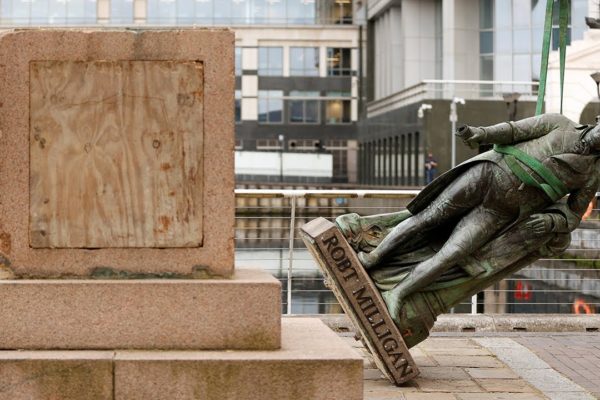The ongoing toppling and removal of an ever-increasing number of statues of questionable individuals leaves us with a realization that parts of our city centers, our campuses and our parks will very likely be permanently altered.
Having lived with certain statues in public spaces for all of our lives, we find that their toppling or removal represents an absence – that is, an empty plinth as a signifier of something that is – arguably rightly and for the better – missing. European civilization has, for thousands of years, relied on statuary to confer greatness and status. Though somewhat culturally and historically entangled, Greek and Roman statuary bequeathed an honorific blueprint that European civilization has found particularly compelling.
Beyond that, statues erected by European colonizers throughout the lands they invaded were always of ruling monarchs or other self-declared European (white) figures of supposed greatness.
In a similar vein, the statues drawing the ire of protestors were for the most part commissioned and erected by privileged, wealthy individuals and groups determined to resurrect and invoke, for their own ends, racially divisive figures. With so many Confederate Civil War monuments erected during the era of Jim Crow segregation, it’s not hard for us to comprehend the schismatic politics behind many of the monuments.
We are at a fascinating cultural juncture, prompted by the questions: What will city centers, university campuses and our parks look like, and how will they resonate, if and when all offending statuary is removed? The removal and toppling of monuments lead us to a greater question: Do we need monuments at all? Or, did we need monuments at all? The answer is a resounding no.
One can confidently assert that only an infinitesimally small minority of monuments and statues across the nation commemorate people of color or people who dedicated their lives to the uplift of all humanity, rather than the subjugation of particular groups of people. For centuries, African Americans and other Americans of color have managed, or been obliged, to get by without statues of people important to their history and wider American history. The country might have to get used to vacated plinths remaining empty, simply because a maturing country realizes that it has no need for deeply problematic, divisive graven images.
An empty plinth signifies more than the laying low of suspect or problematic figures who represent a troubled or contentious history. There is something reassuringly egalitarian about the toppling and removal of certain statues. If we are to truly believe in the principle that all people are equal and deserve equal rights and opportunities, then the message is surely positively reinforced by the removal of divisive statuary.
Any city center, university campus or city park landscape denuded of statuary is surely a significant step toward a radical, cultural recalibration. If we declare that we have no need of adulatory shrines, particularly to those divisive figures, then a significant step will surely have been taken toward our looking for signs of genuine human achievement in places other than atop granite plinths.
A statue toppled or removed from its plinth is not much more than scrap metal, the problem going from one of how to rid ourselves of dubious statuary to one of what to do with the wretched things once they are removed. A maturing nation is surely signified by a growing ambivalence to the millennia-old strategy of statues being created for them to literally look up to.
The missing thing is not really an absence. It is instead a sign of a community, a citizenry, obliged to come to the realization that it has no need of problematic statuary, and those who for centuries and millennia have foisted graven images on us in the name of civic duty have been selling us falsehoods and have finally been caught out.
Eddie Chambers is a professor of art history and African Diaspora art at The University of Texas at Austin.
A version of this op-ed appeared in the Austin American-Statesman, Abilene Reporter News and the Waco Tribune Herald.




